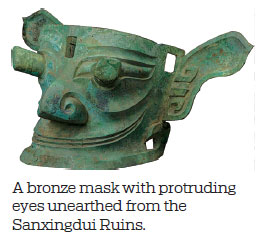Sichuan opens cultural treasures to the world
Province aims to develop tourism industry by promoting heritage sites, unique wildlife and a beautiful, biodiverse environment
Ancient culture, the giant panda and majestic scenery have become three symbols of Sichuan province, a land of abundance in Southwest China.
The province is home to the mysterious Sanxingdui Ruins and Jinsha Ruins, which can be traced back 3,000 to 5,000 years ago and 2,600 to 3,200 years ago respectively. The two historical sites are famous in archaeology for showcasing the civilization of ancient Sichuan.
The Sanxingdui Ruins, unearthed in Guanghan county in the 1980s, shows the civilization formed in the ancient Yellow River region had an impact on the culture of Sichuan, which was located far from the Yellow River. However, the unearthed bronze statues and masks also suggest there was a parallel culture in ancient Sichuan. The site has become strong evidence of cultural integration in the region.
|
Jiuzhaigou Valley is one of five UNESCO World Heritage sites in Southwest China's Sichuan province. Yu Ning / For China Daily |
Sichuan also houses the famous Jinsha Ruins, from which the famous sunbird gold foil was unearthed in 2001.
Since 1993, official statistics show that more than 50 exhibitions have been organized both in China and overseas to show treasures that were collected from the two ruins.
On March 25, a special relic exhibition that focuses on ancient Sichuan culture opened in Rome, Italy. Items from the Sanxingdui Ruins, such as a bronze head with gold foil mask and a bronze mask with protruding eyes, are on display. Some jade relics from the Jinsha site are also on show.

Visitors can find replicas of some very precious cultural relics, such as the sunbird gold foil, bronze celestial tree and a standing man statue from Sanxingdui Ruins, which are banned from exhibition abroad.
Organizers said that this exhibition demonstrates ancient Sichuan's achievements in bronze art and how ancient local artists combined different cultural elements into their works.
Moreover, there will be three lectures for people to learn about Sichuan's protection of Jinsha Ruins, exchange ideas on ancient bronze art and promote Sichuan's traditional culture.
In recent years, foreign guests were invited to Sichuan to showcase their culture. In February 2018, an exhibition was held in Chengdu, capital city of Sichuan, to display items discovered in Pompeii, Italy.
This year, Sichuan also plans to carry out two promotional campaigns, named "Beautiful Sichuan, More Than Pandas" and "The Journey of Famed Sichuan Cuisine Restaurants", to expand its presence in overseas markets and bring about more exchanges.
Giant pandas
Sichuan province is known as "the hometown of giant pandas", being host to 80 percent of the world's giant pandas. Currently, 16 out of the 18 giant panda natural reserves in China are in the region, according to local government.
In 1869, French naturalist Armand David "discovered" the first giant panda in Baoxing county of Ya'an city.
Local chronicles have been published by Sichuan government to reveal stories about giant pandas written over the past 150 years. Taking 12 years to prepare, the chronicles will help expand giant panda culture generation-by-generation, according to officials.
Zhang Jianlong, head of the National Forestry and Grassland Administration and the National Park Administration, said during the 2019 two sessions that the giant panda has become a brand of Sichuan and Sichuan has done a good job to develop the brand.

Sichuan's efforts in protecting the ecological system were also praised by Zhang.
"Sichuan has made a significant contribution in maintaining biodiversity and the giant panda protection," Zhang said.
Officials revealed that several giant panda-themed cultural and creative industrial parks will be built in Chengdu, Pingwu county and Ya'an. The park in Ya'an will have 10 areas including a museum, theme park and tourist service center.
Jiuzhaigou Valley
Jiuzhaigou Valley, a national natural reserve set up for protected animals such as the giant panda and golden snub-nosed monkey, will be reopened to the public, according to Peng Qinghua, Party chief of Sichuan province. The valley, a UNESCO World Heritage site, was closed following a magnitude 7 earthquake in August 2017 and partially reopened a year ago.
Sichuan also boasts four other UNESCO World Heritage sites. They are: Huanglong Valley, Mount Emei-Leshan Giant Buddha, Mount Qingcheng-Dujiangyan Irrigation System and Sichuan Giant Panda Sanctuaries.
In 2018, Sichuan reported more than 1 trillion yuan ($150 billion) in tourism income. During the 2019 Spring Festival, Sichuan received more than 82 million tourists, an increase of 16.6 percent year-on-year.
Looking ahead, Sichuan plans to cultivate leading tourism companies and encourage small companies to strengthen their competitiveness. It will develop premium tourism products to aid brand development.

(China Daily 03/26/2019 page10)



















